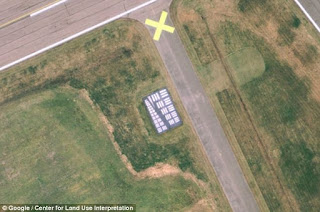 |
| The "bar code" at Walker Field, Maryland |
By itself its existence would be a mystery, or at least a curiosity. Except that it is one of dozens to be known throughout the United States, with most of those found near military bases and other restricted facilities. Some remote locations have entire arrays of the "bar codes" stretching for miles toward the horizon.
So what are these test pattern-ish arrangements? Based on available evidence, they seem to have been put in place by the government during the first few decades of the Cold War. With tensions high between the U.S. and the Soviet Union, the advent of high-altitude aircraft reconnaissance - and then "spy" satellites - became an important asset of military intelligence. And as with any other system of optics those high-flying cameras needed a means of determining that they were properly focused.
The rectanglular codes, therefore, are apparently intended to calibrate the zoom and resolution of aircraft and satellite photography. F'rinstance: letting an SR-71 use one to adjust its precision camera before sending it to fly across the Iron Curtain.
From the original article at Mail Online...
Consisting of a concrete pad measuring 78ft by 53ft and coated in a heavy black and white paint, they are decorated with patterns consisting of parallel and perpendicular bars in 15 or so different sizes.
This pattern, sometimes referred to as a 5:1 aspect Tri-bar Array, is similar to those used to determine the zoom resolution of microscopes, telescopes, cameras, and scanners.
The targets function like an optician's eye chart, with the smallest group of bars discernable marking the limit of the resolution for the camera being tested, according to the CLUI.
'For aerial photography, it provides a platform to test, calibrate, and focus aerial cameras traveling at different speeds and altitudes,' the CLUI adds.
'The targets can also be used in the same way by satellites.'Ironic, aye? That military secrets from fifty years ago are now wide-out in the open because of that same technology and Google Earth. Anyone with a desktop or tablet can now view what likely had been classified top secret by the CIA.
I wonder what else might be on the ground across the fruited plain, waiting to be discovered...







0 comments:
Post a Comment